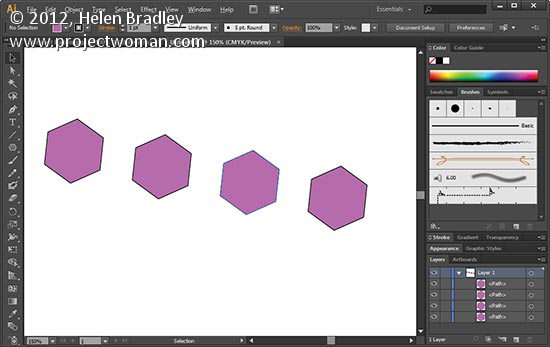Learn to create a vector sunburst in Illustrator – This works with all versions of Illustrator including the new CS6. The process is simple and uses a stroke to make the sunburst – it is quick and doesn’t require a lot of fiddling to create.
Transcript:
Hello, I’m Helen Bradley. Welcome to this video tutorial. In this tutorial I’m going to show you how you can create a sunburst vector shape in Illustrator.
Before we get started creating our sunburst effect let’s have a look and see what it is that we’re aiming for. Here I have a sunburst and it’s just offset in this rectangle, but you could have a circular one if you like.
We’re going to start with circular and then we’re going to crop it to a rectangle. So if you’re ready let’s have a look and see how we create this effect in Illustrator. And we’re going to start by creating a brand new document so I’ll just choose File, New. It doesn’t matter too much what my document looks like.
I’m going to start with the Ellipse tool. So, I’m going to select the Ellipse tool and drag a shape on my image. And I need this to be a perfect circle so I’m going to hold the Shift key as I draw it and then just let go. I want this to be black stroke and no fill so I’m just going to click on the fill here and turn the fill off.
Now let’s go to the Appearance panel for this selected path and I’m going to click the Stroke option. And I’m going to set the stroke to about 200 points. And when I do you’ll see that we get this sort of circle all the way around our shape which is pretty near exactly what we want when we click the Dash Line option. Now with the Dash Line option I can set the dashes to whatever I want and this is going to affect how many of these sunbeam things there are around the shape.
So let’s just go to 20 and try that. This is what I’m a little concerned about. You can see that there’s an uneven spacing here, but you’ll see that you can adjust that by clicking this option here. So just work out how many points you need to get the number of sunrays that you want for your particular shape. I’m going to do a few more in this one rather than less so I’m going to 10 points. And when I’ve got what I want I’m just going to click away from this. And this is the basic shape. Now before we can do anything with this shape we’re going to first have to expand its appearance.
So with the shape selected I’m going to choose Object and then Expand Appearance and then Object, Expand because I want this dialogue here. And I’m going to expand both fill and stroke So I’ll select both of those and click Ok. And now each of these sunbursts is a separate shape and I need now to close up the middle. And I can do that by grabbing the Lasso tool. It’s the easiest tool to use. And all I’m going to do is just drag around because I want to select all the nodes and pointers’ handles in the middle.
Now I’m going to choose Object and then Path, and I’m going to choose Average. And with Average I’m going to select both Horizontal and Vertical and click Ok. And what that does is it just closes up the middle nicely for me. So I’m going to click outside my shape and here is my sunburst shape. So with it selected I can then go to what is now my fill color and I can choose a different fill color for it. And we could fill it with a gradient.
We could do anything we liked at this point. So let’s see now how we’re going to crop it. So I’m going to select the Rectangle tool. I’m going to start by drawing a rectangle and I’m just going to hold the spacebar as I bring it in position over the top of my sunburst because I want to work out exactly where the sunburst is going and where the rectangle is going relative to it. So I think that’s a pretty good position for me. So I’m going to let go of the spacebar and let go of the left mouse button and now select all my objects. I’m selecting other everything, and in the Pathfinder I’m going to select Crop. And that crops the shape to the size of that rectangle. And we lost our fill here so let’s just click on the fill and put the fill back on.
So here is a shape that we could save to our Symbol library. And those sunbursts are very, very easy to create in Illustrator as vector shapes. And of course if you add it to your Symbol library then you’ll have it available anytime you want to use it. And it’s very easy to create ones with different numbers of rays in them.
I’m Helen Bradley. Thank you for joining me for this video tutorial. Look out for more of my videos on this YouTube channel and please like and comment on the videos. Look out too for my website at projectwoman.com. There you’ll find more tutorials and tips and tricks for Illustrator, Photoshop, Photoshop Elements, Lightroom, GIMP and a whole lot more.


